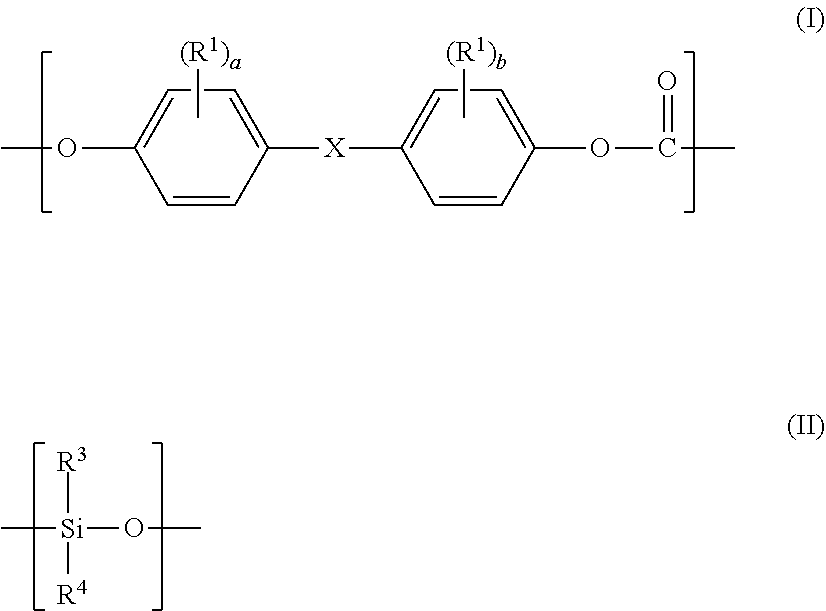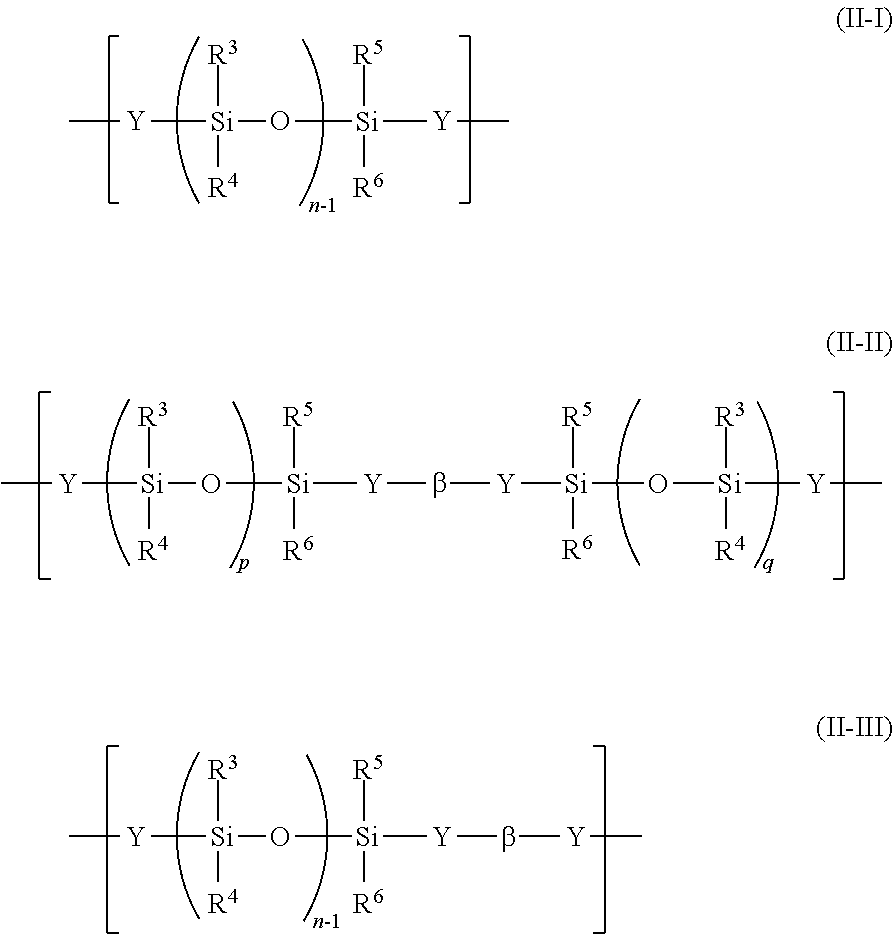Polycarbonate-polyorganosiloxane copolymer
- Summary
- Abstract
- Description
- Claims
- Application Information
AI Technical Summary
Benefits of technology
Problems solved by technology
Method used
Image
Examples
production example 1
[0144]185 mL of the polycarbonate oligomer solution (PCO) produced as described above, 445 mL of methylene chloride, 30.3 g of an allylphenol terminal-modified polydimethylsiloxane having an average chain length “n” of 37, and 0.104 mL (0.75 mmol) of triethylamine (TEA) were loaded into a 1-liter separable flask including a baffle board and a mechanical stirrer with a stirring blade. Aqueous sodium hydroxide A (NaOHaq) (sodium hydroxide: 1.9 g (47 mmol), ion-exchanged water: 22 mL) prepared in advance was added to the mixture under stirring to perform a reaction between the polycarbonate oligomer and the allylphenol terminal-modified PDMS for 20 minutes. Next, aqueous sodium hydroxide B [BisP-AP (manufactured by Honshu Chemical Industry Co., Ltd.): 4.8 g (16 mmol), sodium hydroxide: 2.9 g (73 mmol), ion-exchanged water: 42 mL, sodium hyposulfite (Na2S2O4): 0.006 g (0.038 mmol)] prepared in advance was further added to the resultant to advance polymerization for 20 minutes.
[0145]A so...
production example 2
[0148]Production was performed in the same manner as in Production Example 1 except that: the amount of the allylphenol terminal-modified polydimethylsiloxane was changed to 40.4 g; a solution obtained by dissolving 1.9 g (47 mmol) of NaOH in 22 mL of ion-exchanged water was used as the aqueous sodium hydroxide A; a solution obtained by dissolving 4.8 g (20 mmol) of BisP-B, 2.9 g (73 mmol) of NaOH, and 0.031 g (0.20 mmol) of Na2S2O4 in 42 mL of ion-exchanged water was used as the aqueous sodium hydroxide B; and a solution obtained by dissolving 3 g (10 mmol) of BPA, 5.2 g (131 mmol) of NaOH, and 0.031 g (0.20 mmol) of Na2S2O4 in 77 mL of ion-exchanged water was used as the solution C of BPA in aqueous sodium hydroxide. Thus, a PC-POS copolymer (a6) was obtained. Details about the PC-POS copolymer are shown in Table 1-1.
production example 3
[0149]Production was performed in the same manner as in Production Example 1 except that: the amount of the allylphenol terminal-modified polydimethylsiloxane was changed to 40.4 g; and a solution obtained by dissolving 3.0 g (10 mmol) of bisphenol A, 5.2 g (131 mmol) of NaOH, and 0.006 g (0.038 mmol) of Na2S2O4 in 77 mL of ion-exchanged water was used as the solution C of BPA in aqueous sodium hydroxide. Thus, a PC-POS copolymer (a2) was obtained. Details about the PC-POS copolymer are shown in Table 1-1.
PUM
| Property | Measurement | Unit |
|---|---|---|
| Percent by mass | aaaaa | aaaaa |
| Percent by mass | aaaaa | aaaaa |
| Thickness | aaaaa | aaaaa |
Abstract
Description
Claims
Application Information
 Login to View More
Login to View More - R&D
- Intellectual Property
- Life Sciences
- Materials
- Tech Scout
- Unparalleled Data Quality
- Higher Quality Content
- 60% Fewer Hallucinations
Browse by: Latest US Patents, China's latest patents, Technical Efficacy Thesaurus, Application Domain, Technology Topic, Popular Technical Reports.
© 2025 PatSnap. All rights reserved.Legal|Privacy policy|Modern Slavery Act Transparency Statement|Sitemap|About US| Contact US: help@patsnap.com



